This site uses only a few technical cookies necessary for its operation. By continuing to browse, you accept their use.
To find out more...
To find out more...
Double cooking of vegetables
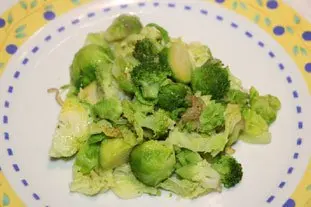
When you cook vegetables, it's not easy to capture and preserve the flavours.
It is easy to undercook, but you can make up for it, or overcook, and then it is unfortunately a bit cooked (in the sense of "ruined").
But above all, how to get the maximum of the taste of the vegetable in the pan, then in your plate, and not in the air of the kitchen or the cooking water?
It's not easy, many cooks will tell you that cooking meat is relatively simple, but that vegetables...
It is easy to undercook, but you can make up for it, or overcook, and then it is unfortunately a bit cooked (in the sense of "ruined").
But above all, how to get the maximum of the taste of the vegetable in the pan, then in your plate, and not in the air of the kitchen or the cooking water?
It's not easy, many cooks will tell you that cooking meat is relatively simple, but that vegetables...
25 K 4.1/5 (27 reviews)
Keywords for this post:CookingVegetablesBoiling waterSaltDoubleTipLast modified on: July 12th 2019
Double cooking of vegetables
Add to all this that, in addition, it is difficult to generalize, that is to say that for such and such a vegetable it is better to do like this while for others it is better to do like that.
But rather than discuss it, I'll take an example with Brussels sprouts, which are tasty vegetables (but that it is easy to completely mess them up by overcooking them, like at the canteen when you were little).
Peel, cut in 4 if the cabbages are big to have pieces not bigger than a sugar cube, and wash with water.
2) First cooking
The cabbages are plunged into a large volume of salted water (1 tablespoon of coarse salt per litre of water), and cooked until they are tender, but not melting, it is very important
3) Cool quickly
Remove the cabbages from the cooking water with a skimmer and plunge them into very cold water, to stop cooking immediately, then drain carefully.
Note that the cooking water at this point is no longer simple salt water, it is already starting to be a vegetable broth, and you should keep it in the fridge after cooling, for other cooking of other vegetables.
4) Second cooking
In a saucepan or a frying pan, heat a large knob of butter or a little olive oil, once hot, add a finely chopped shallot, salt and pepper and cook for 1 minute, without colouring. Then add the vegetables, well drained, and cook for 2 or 3 minutes, hardly more. Serve immediately.
If you don't know, or have never practiced, you might be very surprised by the delicate taste of the vegetables treated this way. Making for example a dish with 3 or 4 different vegetables, in season, with this method, will give you a rather simple dish, just vegetables, but also exceptional in taste and finesse.
- For the seasoning, just salt and pepper you have seen, but some finesse is quite possible, like a little fleur de sel just before serving, or a sophisticated pepper.
- Obviously, and as always, it is much better with seasonal vegetables.
To sum up: The next time you have vegetables to cook, try the double cooking, boiling salted water, then pass in shallot, or onion, sautéed in butter or olive oil.
Insoluble?
No, not exactly, in fact there is a method that gives very good results for almost all vegetables, it is the double cooking.How does it work?
The general principle is that we cook a first time in boiling salted water (cooking called"A l'anglaise", by the French), then a second cooking with a little fat, butter or oil for example according to your taste. This double cooking, even if it is a little longer, is the quasi insurance of a taste of the vegetable revealed and preserved.But rather than discuss it, I'll take an example with Brussels sprouts, which are tasty vegetables (but that it is easy to completely mess them up by overcooking them, like at the canteen when you were little).
The double cooking of Brussels sprouts
1) Peel and wash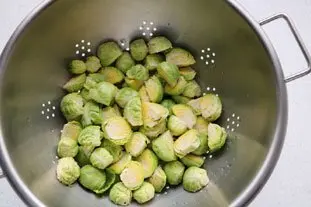
Peel, cut in 4 if the cabbages are big to have pieces not bigger than a sugar cube, and wash with water.
2) First cooking
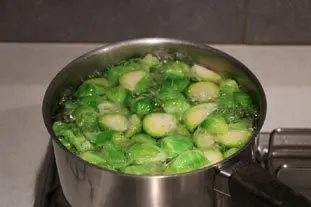
The cabbages are plunged into a large volume of salted water (1 tablespoon of coarse salt per litre of water), and cooked until they are tender, but not melting, it is very important
3) Cool quickly
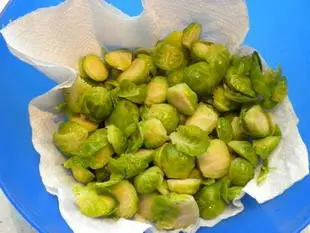
Remove the cabbages from the cooking water with a skimmer and plunge them into very cold water, to stop cooking immediately, then drain carefully.
Note that the cooking water at this point is no longer simple salt water, it is already starting to be a vegetable broth, and you should keep it in the fridge after cooling, for other cooking of other vegetables.
4) Second cooking
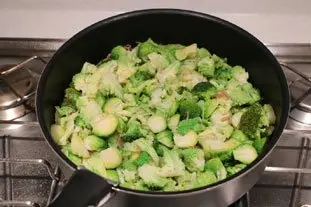
In a saucepan or a frying pan, heat a large knob of butter or a little olive oil, once hot, add a finely chopped shallot, salt and pepper and cook for 1 minute, without colouring. Then add the vegetables, well drained, and cook for 2 or 3 minutes, hardly more. Serve immediately.
If you don't know, or have never practiced, you might be very surprised by the delicate taste of the vegetables treated this way. Making for example a dish with 3 or 4 different vegetables, in season, with this method, will give you a rather simple dish, just vegetables, but also exceptional in taste and finesse.
Some more info-
For an even more delicate taste, use instead of boiling water, a vegetable or poultry stock.- For the seasoning, just salt and pepper you have seen, but some finesse is quite possible, like a little fleur de sel just before serving, or a sophisticated pepper.
- Obviously, and as always, it is much better with seasonal vegetables.
To sum up: The next time you have vegetables to cook, try the double cooking, boiling salted water, then pass in shallot, or onion, sautéed in butter or olive oil.
Lasts posts
Butter vs. grease
We often read in a recipe where a pastry is put into a mould that, just before pouring, the mould should be buttered or greased. But what's the difference between these 2 terms?December 1st 20251,5205
Getting out of the fridge early
Very often when you're cooking, you need to take food or preparations out of the fridge, to use them in the recipe in progress. There's nothing tricky about this: you just take them out of the fridge and use them, usually immediately, in the recipe. But is this really a good method?November 24th 20251,2915
Who's making the croissants?
When you look at a bakery from the outside, you naturally think that in the bakery, the bakers make the bread, and in the laboratory, the pastry chefs make the cakes. It's very often like that, with each of these professions having quite different ways of working, but sometimes there's also one...November 23th 20251,184
Oven height
When we put a dish or cake in the oven, we naturally tend to put it on the middle shelf, and that's what we usually do. But in some cases, this position and height can be a little tricky, so let's find out why.October 8th 20253,3665
The importance of sieving
In recipes that use a fine powder (flour, powdered sugar, etc.), you'll often see the advice to sift before using it. To sift is to pass the powder in question through a sieve (a very fine strainer) before incorporating it into your recipe. It's often advice, but is it really useful?September 3rd 20257,9673
Other pages you may also like
Different kinds of pastry and dough
When cooking in general, and particularly in baking, we can make and use many different kinds of pastry and dough. All built on the same "base": flour - a powder to which we add fat, liquid or both to produce the dough which is then cooked. .November 6th 2012111 K 14.0
Artichoke stalks
When preparing artichokes for cooking, you may well already know that we often need to remove the first round of leaves, if they are tatty or dirty, as well as the inedible stalk. The operative word here is “remove” , rather than “cut off”.October 25th 201654 K4.3
What is the difference between bakery and patisserie?
This is a question that you may well have asked yourself and which I will attempt to answer. In France the two trades of "boulangerie" (bakery) and "pâtisserie" (patisserie and confectionery) have always been quite distinct, but where exactly do the boundaries lie? .February 7th 2017134 K 14.1
Candied fruits: don't get ripped off
Do you like candied fruit? You might like to nibble a handful or add it to a recipe, like a classic fruit cake or delicious Italian specialities like panettone or sicilian epiphany pie.June 21th 201768 K 24.2
A few tips for effective kneading at home
When you have to knead dough for bread or some other recipe, you may well use a food processor or the type of machine known as a stand mixer. The best-known brands are Kenwood and KitchenAid. They are useful tools, but here are a few tips to help you get the best out of them.June 23th 2021284 K 23.8
Post a comment or question
Follow this page
If you are interested in this page, you can "follow" it, by entering your email address here. You will then receive a notification immediately each time the page is modified or a new comment is added. Please note that you will need to confirm this following.
Note: We'll never share your e-mail address with anyone else.
Alternatively: you can subscribe to the mailing list of cooling-ez.com , you will receive a e-mail for each new recipe published on the site.









